All About The Atlantic Tarpon – Facts About Florida Keys Tarpon
The Atlantic Tarpon (megalops atlanticus) is one of the most exciting species of fish alive today. Millions of anglers travel to Florida yearly to catch the “Silver King.” Capable of reaching 8 feet in length and 280lbs in weight, this fish is a formidable opponent for any angler that steps up to the challenge.
Nutrition and Growth
Atlantic Tarpon primarily eat Mullet, pinfish, sardines/pilchards, shrimps, and crabs. This slow-growing fish takes eight years before it can reproduce and 16 years to reach full length. Tarpon lifespans can reach upwards of 60 years. Tarpon have existed since the prehistoric age, roughly 120 million years ago. Researchers say that Tarpon evolved approximately 18 million years ago, which might explain why they can breathe air from above the water’s surface and have giant scales on their bodies that work like plated armor.
Tarpon are hardy, adaptable fish that anglers can find along the eastern coast of North and South America. You can also find Tarpon in freshwater environments such as the Florida Everglades.
Because of their availability, size, and acrobatic fighting style, the Tarpon is undoubtedly one of the most prized game fish in the world. Giant Tarpon will eat baits both large and small alike. A large fish happy to eat such small baits can lead to unexpected encounters and unique opportunities, such as catching a big Tarpon on a fly rod.
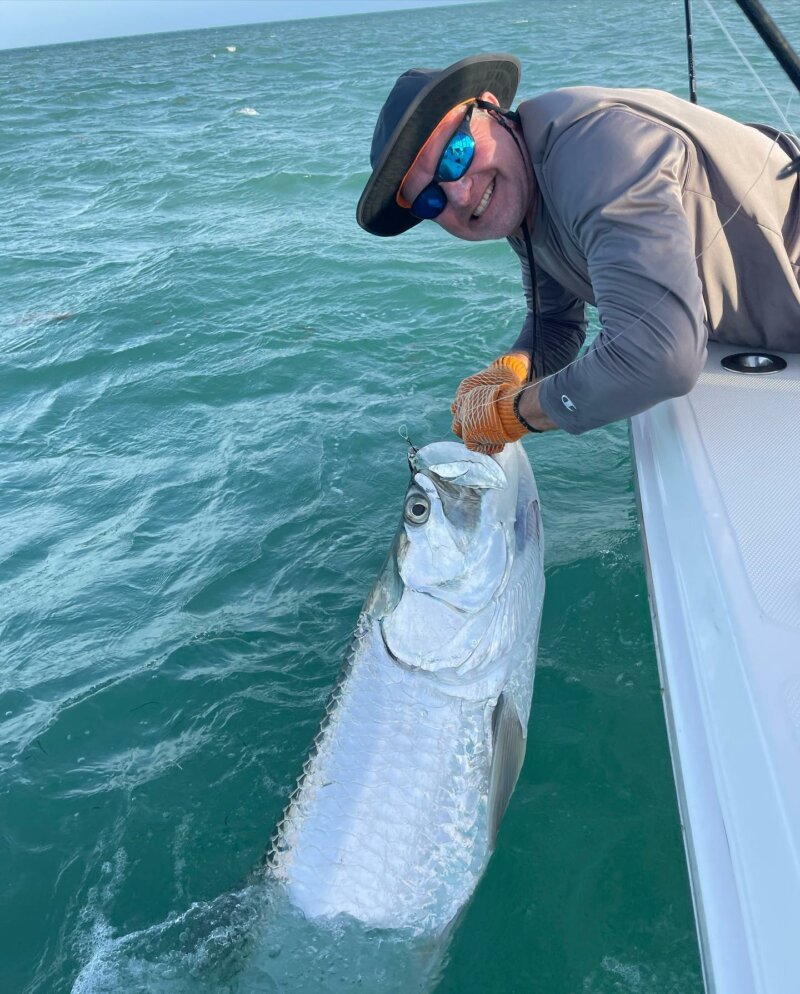
Tarpon are a heavily sought after big game sportfish.
Florida Keys Tarpon
The Florida Keys is arguably one of the best places in the world to find and catch a Tarpon. There are two types of Tarpon that you will find in the Florida Keys. Tarpon that make their home here year-round, and Tarpon that are just passing through.
Seeing Local Tarpon
If you are driving through the Keys from up north, you can make some stops to see large year-round Tarpon along the way. The World Wide Sportsman in Islamorada would be on your right when heading southwest on US1; the Tarpon gather here, and you can observe them while you eat a nice lunch. If you want an up-close look at one, head into the Brass Pro Shop and look at what’s in the massive fish tank.
A little further down the road, you will find the famous Robbie’s Marina, where you can buy a bucket of food to feed the Tarpon. As you head toward Marathon, Florida, the Hawks Cay Resort in Duck Key has a marina that is home to some large Tarpon.
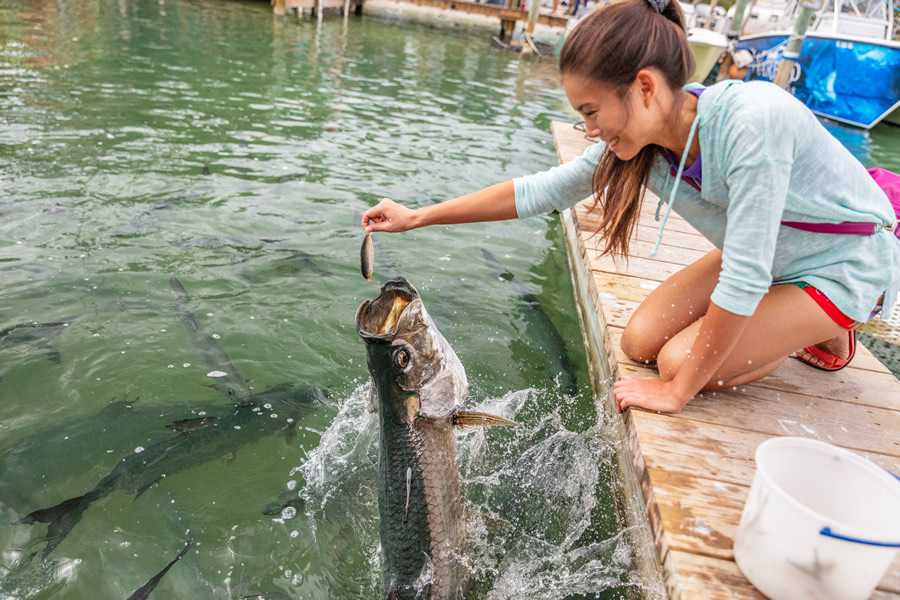
Some marinas in the Keys let you feed Tarpon by hand.
Fishing Local Tarpon
With a little creativity, you can target local Tarpon without a boat if you can think like a fish! An example is the Hurricane Hole Marina right before the last small bridge into Key West. The Tarpon hang out by the cleaning tables during the day but sometimes, after dark, between midnight and 3 am you might hear them splashing and hunting prey under that very bridge. If you can get a live bait under that bridge that resembles their prey, you might get a shot at a Tarpon! Just make sure you have the required fishing license and are on public property, of course.
Marathon, Florida, is full of canals that hold Tarpon behind people’s homes. If you befriend a local with a home, you might be able to fish Tarpon from their backyard! Just make sure you have a fishing license and follow the local laws.
Additionally, you can find year-round Tarpon in their more natural environments near mangroves and flats. If renting a Kayak or small boat to search for them doesn’t work, you can always hire an experienced guide that can help you find Tarpon. Fishing professionals in Florida are very talented at finding fish as it is how they make their living.
Seeing Migratory Tarpon
As water temperatures rise above 75 degrees in late April, schools of Tarpon begin to travel down Florida’s Gulf and Atlantic coastlines. These fish can be seen from bridges and boats as they gently stick their mouths out of the water to get some air before “rolling” back under the water. While these fish travel, they stop to rest and feed in areas along the coastline. When inshore feeding, Tarpon frequently ambush baitfish being forced between bridge pilings by strong currents.
One of the best places to see this is near the famous 7-mile bridge in Marathon, Florida. You can walk along the old bridge and look for them from a bird’s eye view during the migration. These transient Tarpon also frequent the Bahia Honda State Park bridge, the Long Key bridge, and many other bridges in the Keys.
When the moon phase is right, our crews sometimes witness large schools of more than 100 Tarpon heading far offshore together. Seeing so many fish over 100lbs in size is an incredible sight to behold. You can cast all the bait you want at one of these schools; they will not bite; they are focused on a critical mission to spawn offshore and get back to the coastline safely.
Fishing Migratory Tarpon
The best way to target these Tarpon is where they are feeding while presenting them with what they are already eating in a particular area. For instance, at the Bahia Honda Bridge we use live crab to catch Tarpon. Under the Seven Mile Bridge, live Mullet is the bait we use. This bridge fishing often results in our clients catching large Tarpon in the 80-150lb range.
Tarpon feed well in the morning or evening but can be caught throughout the day as well. We only tend to fish for Tarpon in the evening as we spend our days catching Mahi and Tuna offshore this time of year.
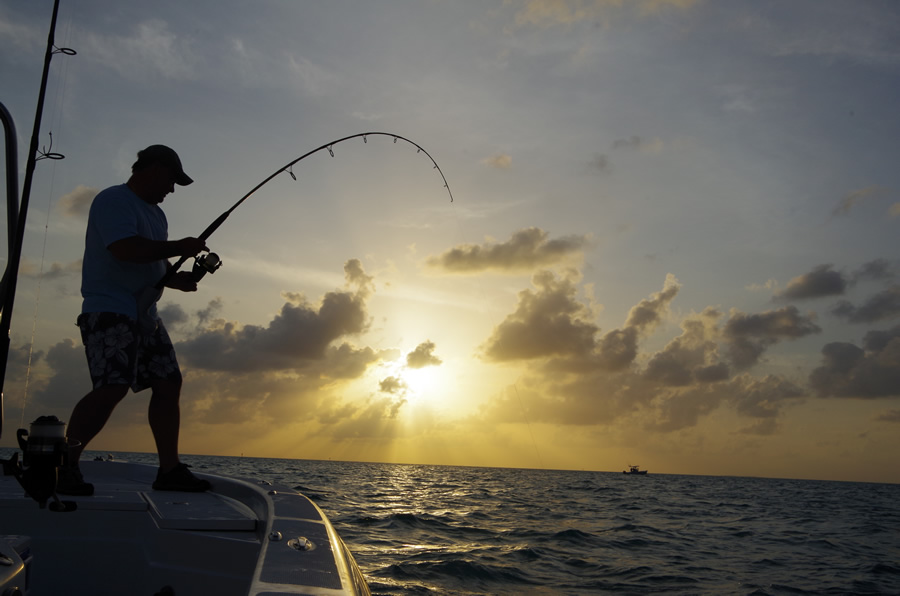
We primarily target Tarpon in the evening.
In late May or early June usually, during a full or new moon, you might get to witness an incredible phenomenon called the palolo worm hatch. When the tide and moon phase is right, these 3-4 inch long worms leave the safety of their coral homes and can be found swimming throughout the water column in massive numbers to spawn.
This happens to be the time of year when the most Tarpon are gathered in the Florida Keys. This may not be a coincidence as the Atlantic Tarpon LOVES to eat Palolo worms. It is incredible to watch schools of Tarpon rolling on the horizon as they appear intoxicated with glee from eating these worms. This time of year, we usually fish under the Seven Mile Bridge and can see these worms in the water.
If you time it right, this event can improve your odds of hooking a Tarpon because of the sheer number of fish in the area. As the Tarpon gorge on these worms, eventually, the bite may cool off. You might see a Tarpon stuffed to the gills on worms lazily chasing your live Mullet out of instinct more than hunger. That may or may not result in actually hooking the fish.
It does make sense that if the Tarpon have millions of worms to eat, they might not care about eating your live bait. It doesn’t hurt to have a small worm lure or a borski worm fly to work while your live bait swims in the current. If your live bait doesn’t work you could get a bite from a tarpon mistaking the lure for a Palolo worm.
In June and early July, we stop bridge fishing and target Tarpon in channels, inlets, and along edges of grass and sand. By now, many of the schools of Tarpon have spawned and are starting to head back up the coastline. It will take plenty of energy to make that swim home, so the Tarpon will be feeding well.
By now, Mahi season is in full swing, so we have tons of Dolphinfish (Mahi) heads and carcasses that we have been saving from our offshore trips. We use this to chum the water and attract Tarpon. Among all that chum, we drop strips of Mahi bellies, gill plates, and other bloody bits with a circle hook and wait for an opportunistic Tarpon to eat it. We have had a lot of success hooking large Tarpon from 60-120lbs this way. Just be prepared that you may also inadvertently hook a barracuda or a wide variety of sharks when doing this.
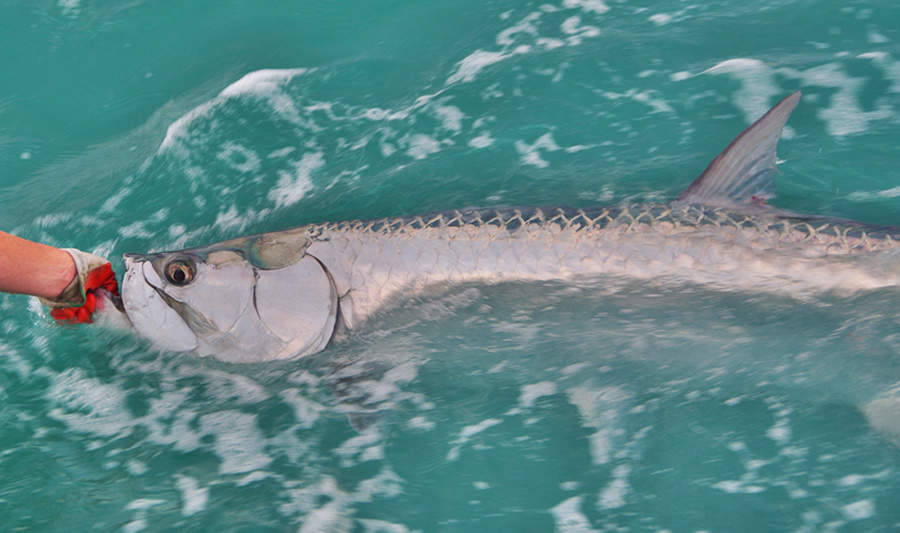
Before handling a Tarpon, make sure that you have tuckered it out first.
Fighting A Tarpon
Before you even fight your Tarpon, you need to hook the fish, which should be done with a circle hook. Tarpon have boney mouths but today’s modern, laser sharpened circle hooks are great at finding the corner of their mouth. Do not violently set the hook, it is not necessary with a circle hook. The fish will panic and likely run when it feels the hook or the line. It will likely run upwards of 70+ yards before taking an incredible leap out of the water. The force of the fish running and pulling drag and your initial controlled lift on the rod should set the hook for you. This is why it is best to fish Tarpon from a boat, as battling large Tarpon from land is very difficult since they make long runs and can spool you quickly.

When first hooked, Tarpon will often run and leap as they try to spit the hook.
Seeing a 150lb fish leap out of the water and perform a somersault as it tries to throw the hook is awe-inspiring. Witnessing this event is shocking and exciting, which has caused many anglers to freeze in awe, resulting in the fish spitting the hook and swimming away!
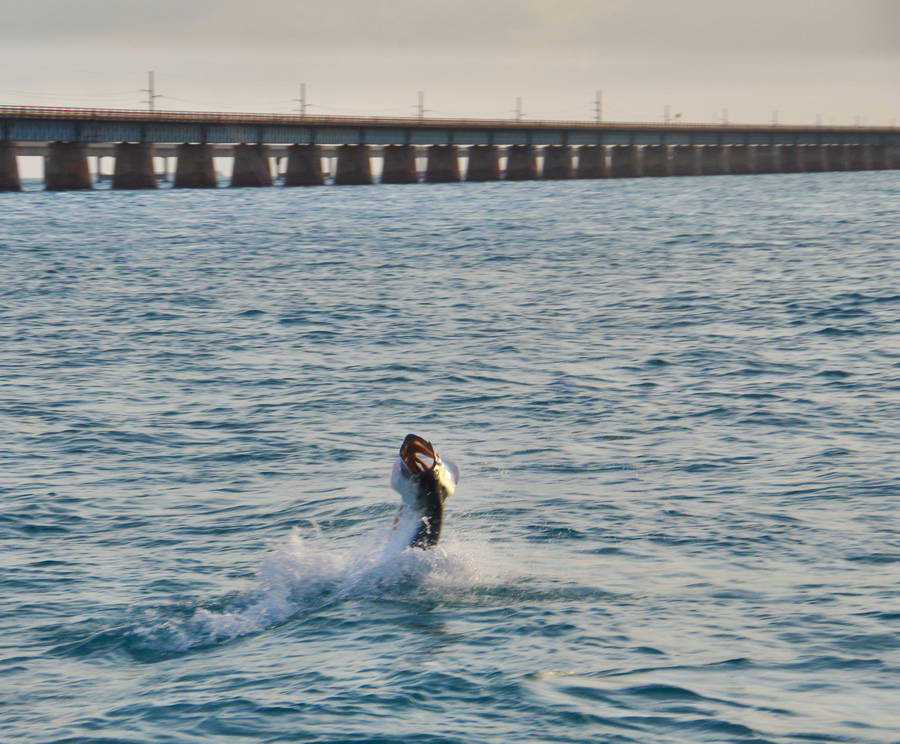
A large Tarpon hooking up near the Seven Mile Bridge in Marathon, Florida.
When you initially hook the Tarpon, you want to watch the line in the water, as it will rip through the water in a fast upward motion right before the fish jumps. If the fish jumps away from you, it is best to “bow to the king” which means taking a bit of tension off the line by pointing your rod at the fish and bowing forward or extending your arm.
This can be tricky as most of us learned to keep the line tight to keep a fish hooked. But in this case, if you do not create some slack, the line will yank the hook out of the fish’s mouth as it shakes its head violently mid-air. If the fish is jumping toward you, it is already creating the slack, so bowing is unnecessary; just make sure to reel up the slack, so the fish does not land on the line, getting wrapped up in it.

A hooked Tarpon attempting to spit the hook on a Main Attraction customer.
As soon as the fish is back in the water, resume keeping the line tight. You want to slowly lift the rod tip up and then quickly wind as you slowly lower the rod back down. By repeating this action to retrieve the line you should eventually catch the fish. Do not wind against the drag, if the fish is taking line out do not turn the handle, the drag is already tiring the fish out. Winding against the drag during a jump will pull the hook and twist the line badly, which can cause tangles.
Maneuvering The Boat
Fighting a Tarpon is a team effort. Once the fish is hooked, the Captain must get off the anchor as quickly as possible before the angler runs out of line. We implement an anchor ball system to allow for us to throw the line quickly. When hooked, a Tarpon will try to break your line off on rocks, pilings, docks, anchor lines, and anything else to cause you grief!
Tarpon do not just use their gills for breathing; they have a lung-like swim bladder that allows them to gasp air with their mouths from above the water’s surface. During your fight, the fish can come up and gulp some oxygen before making another run, giving them the ability to fight longer and harder than other fish. This ability means that Tarpon are comfortable in shallow water and low oxygen environments. Sometimes they bring you into channels and canals or shallow water where your boat might not be able to go.
Sometimes a Tarpon on the line will head straight offshore for deeper water! Either way, you will have to try and put the boat wherever you need to land the fish; sometimes, that can be miles from where you first hooked up. It helps to have an experienced Captain in this scenario as it can be tricky to navigate these obstacles safely.
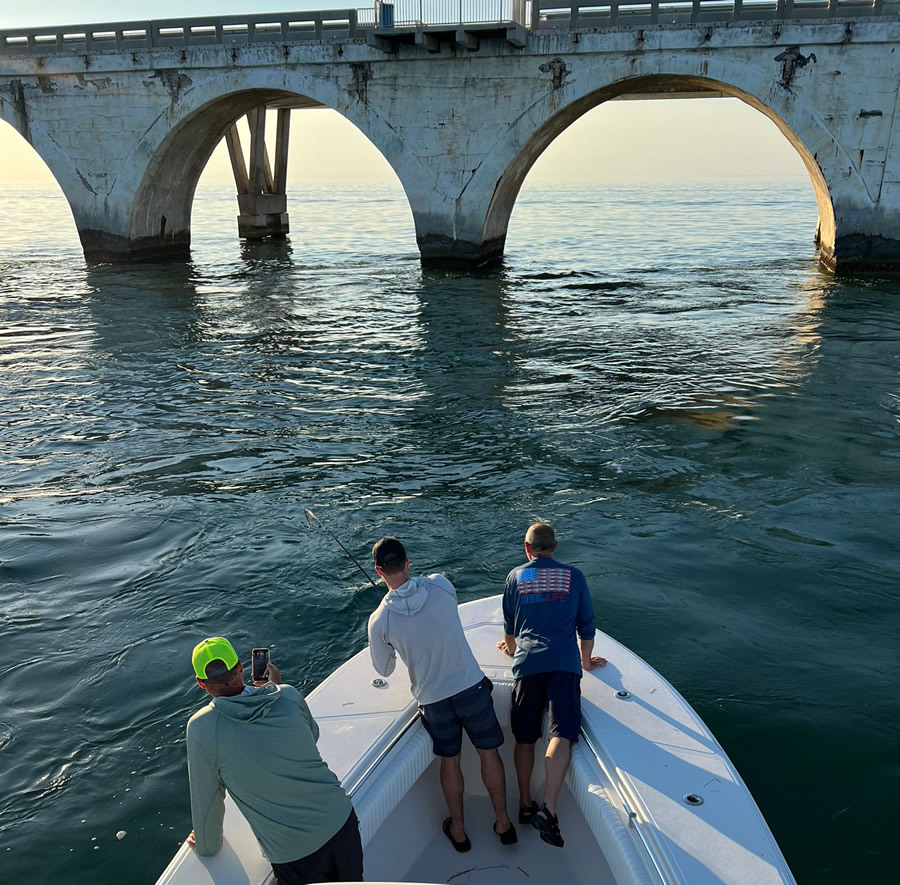
Navigating the environment while fighting a Tarpon can be tricky.
Conservation
If that wasn’t enough to worry about, an enormous shark may show up and try to eat your Tarpon. If you see this happening, you should cut the line to give the fish a chance to escape. If a hungry Hammerhead or Bull Shark that weighs several hundred pounds sees a Tarpon over 100lbs struggling to swim, it will bite it in half in seconds!
Tarpon are beautiful majestic fish that have been around since prehistoric times, and deserve our utmost respect. In the Florida Keys, the Tarpon fishery is catch and release. The only exception is if you have a special tag to keep one in the pursuit of a state or world record.

Main Attraction customers getting a quick pic before releasing their Tarpon.
The FWC regulation at the time of writing this is that Tarpon over 40 inches must remain in the water. Just a few years ago It was once quite common to see pictures of customers with Tarpon entirely out of the water. Research shows that taking large fish out of the water can damage vital organs. This is why regulations have changed, and now anglers often get in the water to take photos with their Tarpon!

It is not unusual to see an angler jump in the water to snap a photo with a Tarpon!
Tarpon have many bones, and extracting their meat would be cumbersome, so they are considered to have poor food value. Fortunately, there are many tasty fish in the Atlantic that we are allowed to harvest and are easy to fillet!
The days of needing to kill a Tarpon to mount it are also in the past. We are partnered with Gray Taxidermy, who can create a beautiful replica of your fish made in fiberglass. With these efforts to help protect the Atlantic Tarpon we hope the tradition of catching and releasing this beautiful animal will last many years.
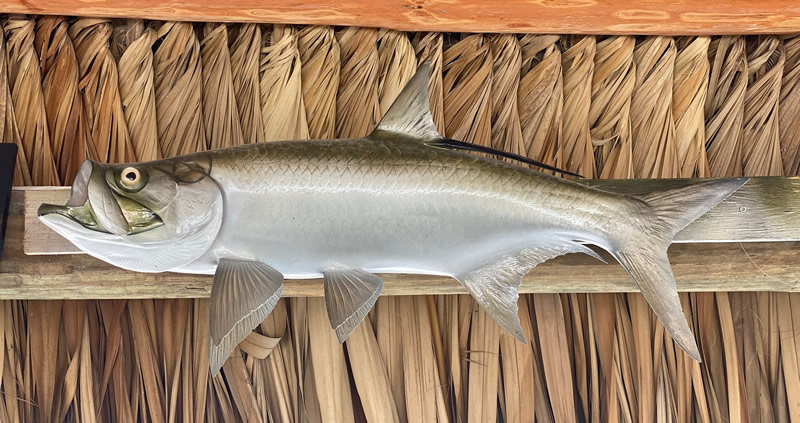
A fiberglass Tarpon mount at our Marina that was made by Gray Taxidermy.
If you are interested in hiring a charter to fish for Tarpon in the Florida Keys feel free to call us at 305-289-0071 or visit our contact page.




